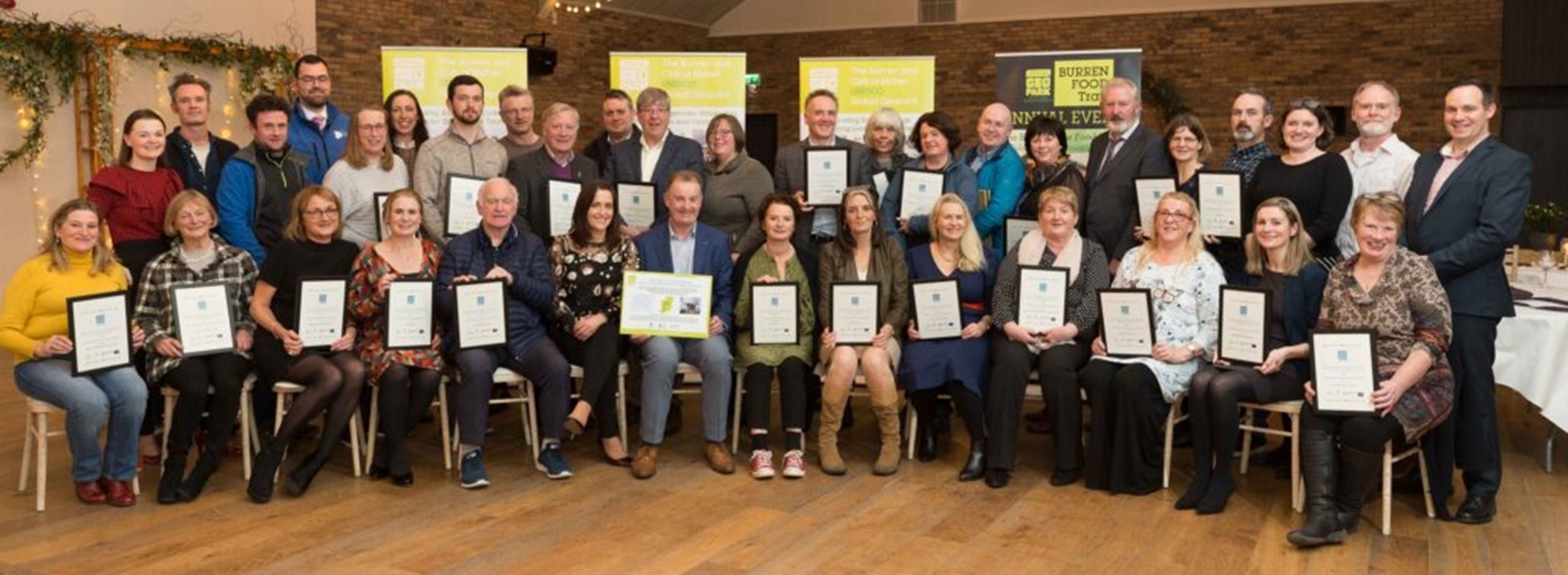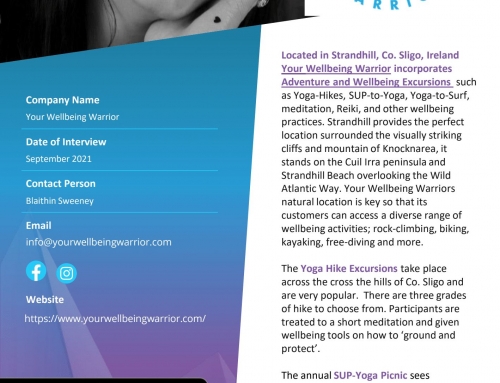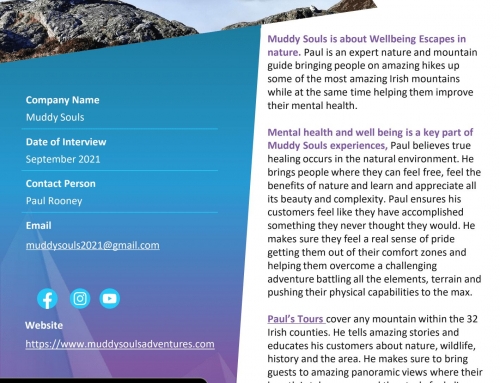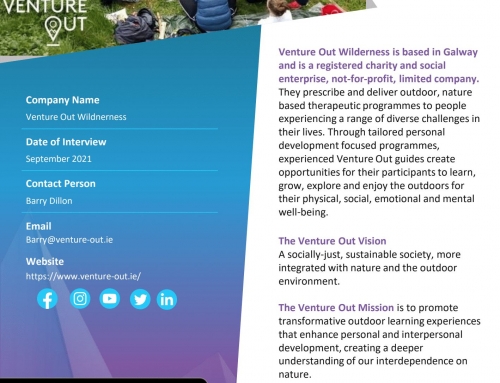Example of an Irish Regional Approach to Supporting an Environmentally Sustainable & Eco Tourism Destination
The Burren National Park, Clare is an example regional support model of how enterprises can flourish through a dedicated support network led by a partnership between a network of enterprises, tourism enterprises and a National Geopark creating the BEN Burren Ecotourism Network . They have made significant contributions being innovators, collaborators, and positive change makers in their environmental, social and economic community.
CASE STUDY
Burren National Park, Clare, Ireland
Eco and Environmentally Sustainable SMEs, Partnerships and Community Approaches
The Burren a UNESCO Global Geopark is a mountain landscape region in County Clare, southwest of Ireland. Located on the Wild Atlantic Way and beside the famous Cliffs of Moher and Doolin village, a renowned centre for traditional Irish music. The word “Burren” means a rocky place. It is a karst landscape of bedrock incorporating a vast cracked pavement of glacial-era limestone, with cliffs, mountains, caves, fossils, rock formations and archaeological sites. It is a unique and alluring landscape with outstanding geological heritage, rich fertile valleys, vibrant villages and thriving communities and tourism businesses that offer some truly inspiring food, heritage and activity experiences. Over 1m Visitors come every year for a range of reasons, from archaeology to adventure and geology to botany.


Sustainable Environmental Friendly Enterprises
The Burren knows they need thriving communities and a way of living that doesn’t harm their environment and culture. They understand that the reality is that one can’t exist without the other. They need a protected environment to ensure a prosperous local economy and a rich quality of life for all.
1. Agri-tourism enterprises (focus on upland/lowland methods, farm stays, rural and agricultural activities, etc.), training and product development are provided by Chambers of Agriculture.
Businesses Burren Farm Experience (eco-tourism organic food, agri-camping, hire a camper, tours etc), Burren Glamping (converted horse trailer on organic farm for 6 people), Boston Farm House Self Catering (cosy cottage on a farm with lake views, fishing, pony rides…)
2. Adventure Tourism Something for everyone; cycle, hike, kayak, climb, explore and discover fascinating landmarks and important geological sites all over, above and below the Burren. The best way to explore the Geopark is to take the time to sensitively wander – by foot or on bicycle. (guided walks covering topics such as Burren flora, fauna and geology, 7 way marked walking trails ranging from 30 minutes to a three hour walk over limestone hills and mountains)
Businesses Doolin Cave, Burren Birds of Prey Center, Doreen Drennan Art Studio, Garden and Lodge, Cliffs of Moher Cruise, Clare Coastal Walk or Aloha Surf School
3. Food Tourism The Burren has a rich food culture and is the perfect location for foodies who want to follow the path their food takes from farm to fork. The Burren Food Trail offers a way to uncover the history of the region through its food. The trail and its weekly food series offer the chance to explore the unique and ancient farming system of the Burren, to meet the producers, hear their stories and to dine in award-winning Chef-lead restaurants. There are 5 themed trails (Farm to Fork, Cheese, Natures Child, Market Garden and Taste the Ocean) The Burren Food Trail were winners of the “European Destination of Excellence – Tourism and Local Gastronomy” (EDEN) award for developing a tourism offering based on their local gastronomy that balances sustaining the local environment with the promotion of viable tourism.

Businesses Hylands Burren Restaurant and Pub, The Roadside Tavern, The Ivy Cottage, Monks Ballyvaughan,
4. Education Outreach Programs for schools on environmental awareness and the ecology. Farmers learn heritage conservation through Burren Farming for conservation Programme, The Burren Connect Project and get support and mentoring form Burren IFA, Burrenbeo Trust Ltd, Galway County Council and Clare County Council.
Businesses The Farmyard is an interactive farm rooted in a healthy, natural and organic ethos that encourages people to live, work and play in a natural way. They provide Summer Camps, Farm Camps and Cookery Camps. Learn how to milk a cow, make butter, gather and sheer sheep, make soda bread.
5. History, Cultural Tourism Get up close to nature and heritage. Immerse yourself in rich heritage. Discover the local culture. The Dromore Wood Reserve is full of natural, historical and archaeological assets. The 17th century O’Brien Castle, Cahermacrea Castle and Kilakee Church, two ring forts, a limekiln, a children’s burial ground and a chapel. Find rare Irish Pine Martins, Red Squirrels, Irish Bats, butterfly species. The rest of the Burren has numerous archaeological remains and a lot of stone buildings such as tombs, ring forts, early Christian churches, medieval tower houses and old buildings related to farming across the centuries. Finally, the Burren is a land with a strong culture: art, literature, craft, storytelling and music, all an important part of the local identity.
Businesses Lisdoonvarna Matchmaking Festival, Doolin Traditional Music Village, Father Ted’s House, Moher Cottage, Michael Cusack Centre, Gregans Castle

6. Ecotourism, Geology, Wildlife and Environmental Tourism In the stunning surrounds of the Geopark you will find the longest cave system in Ireland, the largest stalactite in Europe and more. A designated special are of conservation with famous and unusual habitat, famous for flowers, plants, arctic alpine plants, Mediterranean plants, calcicole (lime-loving) and calcifuge (acid-loving) plants, species (butterflies, birds, fish, reptiles etc.), woodland plants, geology formations within one unique ecosystem.
Businesses Aillwee Cave, Cliffs of Moher, Burren Nature Sanctuary
BEN Burren Ecotourism Network
B.E.N. (Burren Ecotourism Network is a network of tourism enterprises with the objective of establishing the Burren as a premier internationally recognised sustainable tourism region ensuring the future economic and social growth and sustainable development of its communities, environment and heritage. It started in 2008 when The Burren Ecotourism Network and the Geopark joined together in partnership to form a special relationship, when the Burren Connect Project first instigated the establishment of the Network. Full list of members
The Network aims to be a recognisable network of enterprises who have achieved independent accreditation, demonstrate ecotourism ‘best practice’, positively discriminate in each other’s favour, provide ‘one voice’ representation on issues impacting the Burren (where appropriate), and inspire conservation activism. It seeks to support continued training, mentoring and accreditation in sustainable tourism for its members and for businesses interested in joining the Network.
They two organisations work in partnership, pooling their resources in pursuit of their common objective, are committed to the promotion of responsible tourism that conserves the environment and improves the well-being of local people. They work together to promote ‘The Burren & Cliffs of Moher Geopark’ as a leading sustainable visitor destination, celebrated for high standards in visitor experience, conservation and learning.
The BEN consists of experts, professional stakeholders and enterprises in the agricultural sector, environment, food quality, rural development, etc. It has a quality label e.g., for the farming category there is a network of farmers providing tourist products and experiences (farm stays, outdoors/agricultural activities, local produce, etc.) and dedicated farmers’ market to ensure the consumers that the producers are local, and the produce is authentic. Chambers of Agriculture also provide training for farmers that want to diversify into tourism activities.

Delivering Sustainable Tourism as a Partnership
BEN works hard to play our part to ensure this happens for the local population. So everyone is considered; local community, residents, farmers, businesses, schools, tourists or interested groups. Since evolvement they have developed a range of activities, projects and courses including a Code of Practice for Sustainable Tourism to help businesses in a destination to work together for the benefit of their local business, environment and the well being and livelihood of the local economy.
The Burren delivers its Sustainable Tourism through 6 key areas;
1. Partnering with Communities
2. Partnering with Local Businesses
3. Managing Heritage Sites
4. Sustainable Tourism
5. Coach Tourism
6. Best Practice Resources and Studies
1. Community Conservation by Partnering with Communities this model develops the skills base of the community stakeholders in the understanding, management and conservation of the natural and cultural heritage of the Geopark region. They have developed guidelines for working with communities on conservation systems.
- Working with local schools, scientists and experts developing courses, research and compiling resources.
- Satisfaction Survey so they can improve the environment, protect amenities, provide more knowledge and better manage tourism
- Develop skills in practical training in conservation management and delier the GeoparkLIFEproject.
- Adopt a Hedgerow; businesses take care of the hedgerows around their businesses, clear litter, remove invasive plants, protect species.
- Meitheal/Giving Back where locals repair damage to farmlands and walking routes provided by farmers. Help farmers save their crops, rebuild and repair stonewalls, help other businesses in need.
- An Cabhail Mhor is a model where their community groups work to undertake conservation work in their locality through partnership with other agencies; The Burren and Cliffs of Moher Geopark are working with the National Monuments Service, Clare County Council, the Office of Public works and the Kilnaboy Historical and Heritage Group (KHHG), a community group, towards the conservation of An Cabhail Mor, a 17th Century building in a bad state of disrepair in Kilnaboy.
- Ballyvaughan Tidy Towns where they developed a template and recommendations on engaging community development groups to highlight and protect heritage and biodiversity.
- Lisdoonvarna Spa Wells facilitating the revival and potential of tourism assets ictorian Spa Wells Complex, a Twin Wells, a Pavilion Town Hall, 50 acres of undeveloped lands, and Maiville House.
2. Partnering with Local Businesses to be sustainable by playing an active role in conserving their environment which in turn can sustain their tourism industry. They hae developed a model for partnership with tourism businesses that gives environmental, social and economic benefits to the businesses involved and around the region.
 The Code of Practice for Sustainable Tourism and its supporting training and mentoring programme is essentially a framework that will allow businesses in a destination to come together to build a sustainable tourism offering, the framework also allows each business that engages in the code to develop an environmental action plan. The Code of Practice includes 6 key areas of good practice A Cared For Landscape, A Well Understood Heritage, Vibrant Communities, Strengthened Livelihoods, Sustainable Environment Management. ‘These are commitments to a process of continuous improvement in sustainable tourism practice’.
The Code of Practice for Sustainable Tourism and its supporting training and mentoring programme is essentially a framework that will allow businesses in a destination to come together to build a sustainable tourism offering, the framework also allows each business that engages in the code to develop an environmental action plan. The Code of Practice includes 6 key areas of good practice A Cared For Landscape, A Well Understood Heritage, Vibrant Communities, Strengthened Livelihoods, Sustainable Environment Management. ‘These are commitments to a process of continuous improvement in sustainable tourism practice’.
Deliver a training program focusing on modules on interpretation, visitor communication, sustainable transport and conservation. The training programme is highly practical providing enterprises with the tools to establish baseline information and benchmark standards in the areas of energy, water, waste-water and waste management. At the end of the training programme each business is equipped with the necessary guidelines, templates and resources to draft an environmental policy that is appropriate to their own business and on reaching the code each business will have crafted an environmental action plan.
3. Managing Heritage Sites as the Geopark landscape is a mosaic of specialised natural habitats, hosting unique and varied flora and fauna. Through taking a partnership approach involving the managmene agencies and landowners of the region they have developed an integrated management approach to ensure the best management of their sites.
4. Coach Tourism the Geopark saw a significant increase in coach tourism in recent years. In 2014 the Burren and Cliffs of Moher Geopark commissioned a year long study of coach tourism in the Geopark region so they could better manage its impact. In 2017 the Burren and Cliffs of Moher Geopark commissioned a one day coach traffic survey.
5. Good Practice Resources and Studies the Geopark have since 2012 partnered with community groups, local businesses and stage agencies to establish good practice guidance, guidelines and case studies so the region could learn how to balance tourism and conservation in high nature value destinations. They commissioned a number of independent studies.
Externally The Burren endorses Leave No Trace 7 principles to guide visitors towards better environmentally friendly choices.
1. Plan Ahead and Prepare
2. Be Considerate of Others
3. Respect Farm Animals and Wildlife
4. Travel and Camp on Durable Surfaces
5. Leave What You Find
6. Dispose of Waste Properly
7. Minimise the Effects of Fire




